
This is a quick or faster way to make really good croissants at home. It is easy and the video really shows you all the steps to success.
The Croissant is one of the most famous pastry in the world… It has become an icon to France and the capital city of Paris. A croissant is described has a buttery, flaky, delicatessen.
The viennoiserie pastry took its origin from Vienna of Austria and was brought to France by late Queen Marie-Antoinette. The historical crescent shape comes from war against the Turks who have a crescent on their flag. Croissants and other viennoiserie are made of a layered yeast-leavened dough. Traditionally, the dough is layered with butter, rolled and folded several times in succession (pastry chefs call the folds turns), then rolled into a sheet, in a technique called laminating. The process results in a layered, flaky texture, similar to a puff pastry. Nowadays, many bakery or mass production uses margarine to make the croissants.
However, as I often say there is no pleasure without butter. So, this recipe is buttery and divine.
Happy Baking.
Frenchy.
Ingredients
-
Dough starter
- The dough ( to add to the starter)
- for the lamination (flaky layers)
Instructions
-
The Starter dough
-
Gather your ingredients. Best you use a Bowl mixer for this recipe with a dough hook... No fresh yeast no panic you can use Dry yeast instead... But you must find Bakers flour ( high protein flour 1-14% for elasticity)
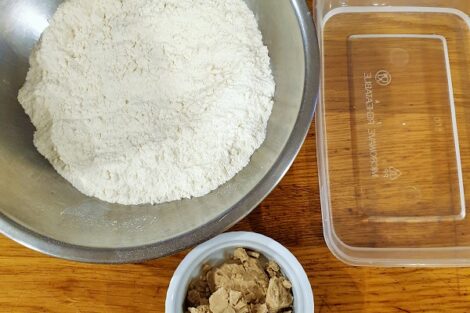
-
Add the tepid (warm water to the bowl) with the flour

-
Add the yeast (fresh or dry)
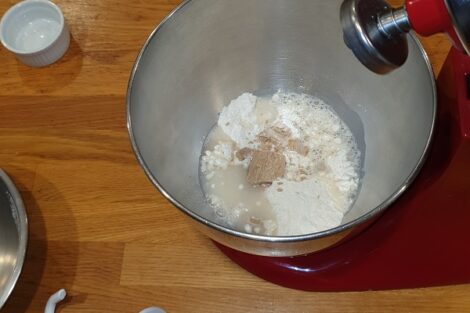
-
Mix slowly first until all the ingredients are combined and increase the speed to level 4 on a kitchen aid
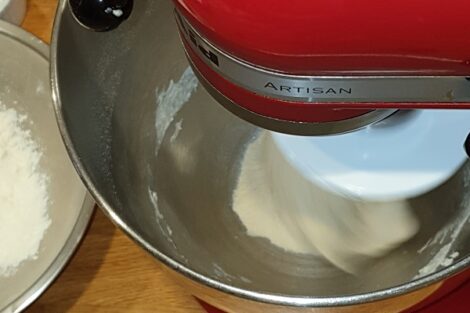
-
Mix for 5 min.
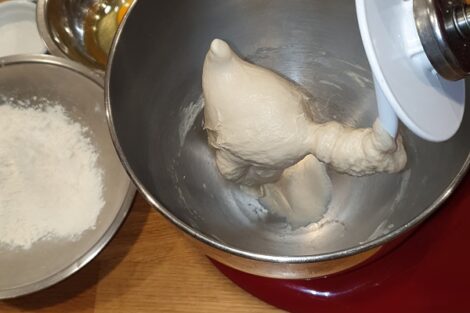
-
Check the starter dough. it should be smooth, detached from the side of the bowl.
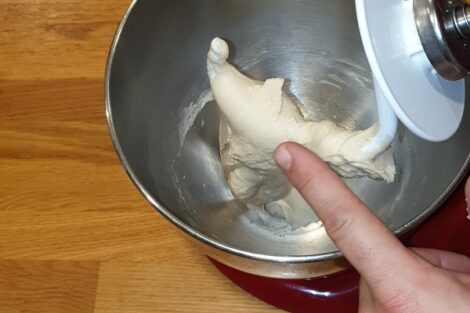
-
The dough should be a little sticky to touch.

-
Leave the dough in the bowl and cover it. rest in a warm area for 30 min or until it double in size.
 The dough-ingredient to be added to the starter
The dough-ingredient to be added to the starter
-
Meanwhile, prepare the next ingredients to finish the dough.

-
See the dough has risen

-
Add the flour to your starter.
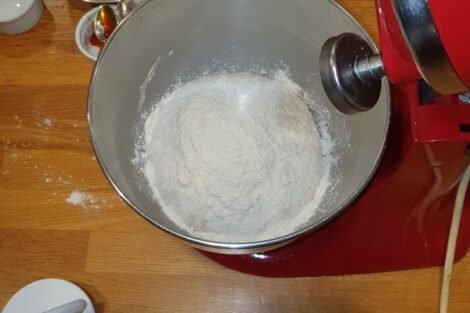
-
add the sugar.
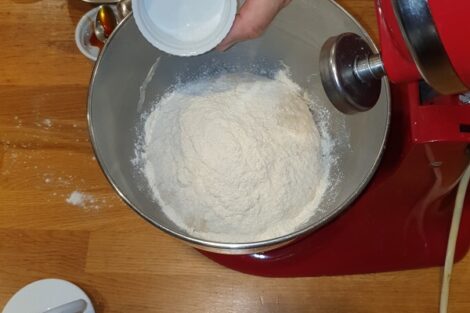
-
Add the salt.
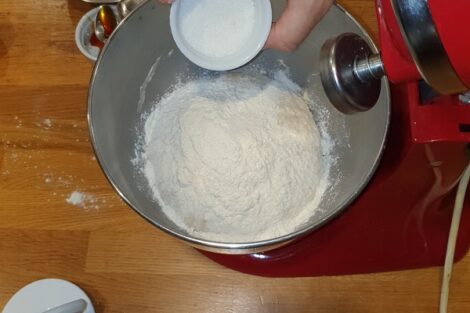
-
Add the honey. this increase the flavour and accelerate the fermentation.
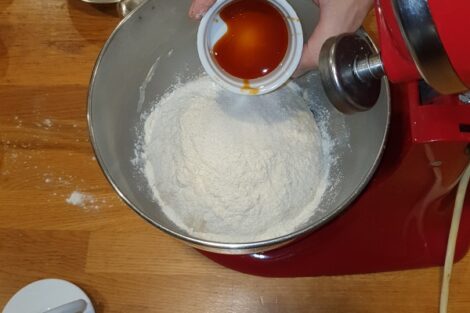
-
Add the egg.
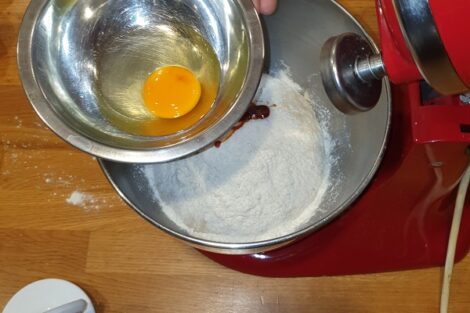
-
Get the dough hook ready.
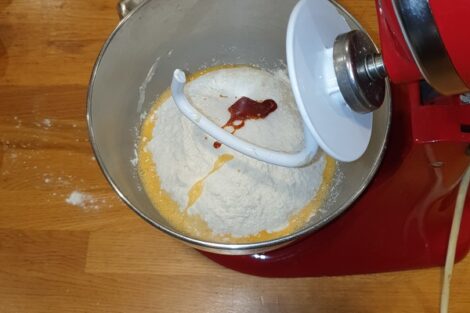
-
Mix gently for a minute.
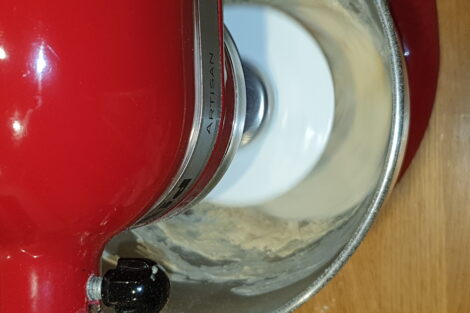
-
Intensify the speed to level 4 on a Kitchen Aid. Mix for 8 minutes.
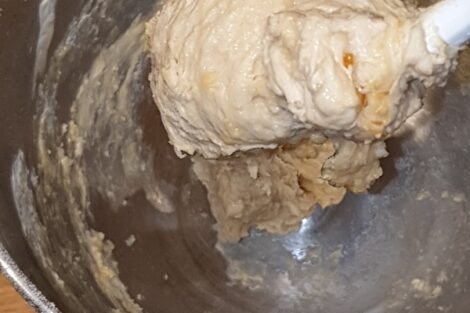
-
Then accelerate the speed to 8 or 75% speed on other mixing bowl machine.
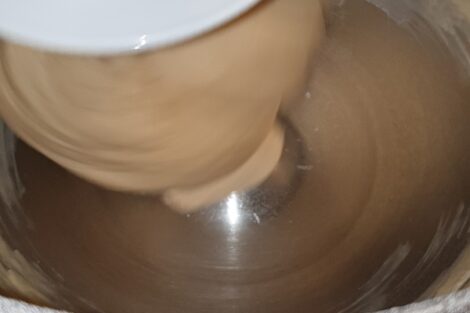
-
The dough should appear slick and non sticky to the bottom of the bowl.
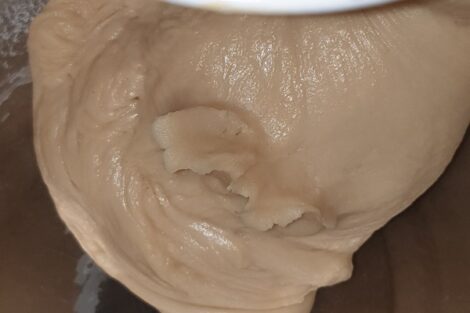
-
Remove the dough from the bowl.

-
cover and place it in the fridge for 30 minutes.
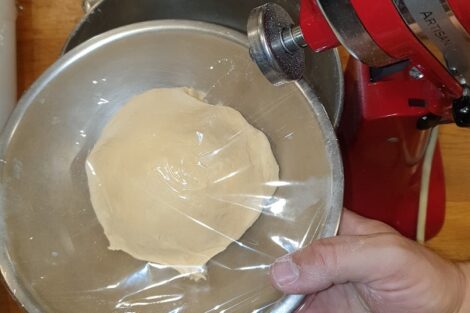 Preparing the butter
Preparing the butter
-
Meanwhile, prepare your butter.
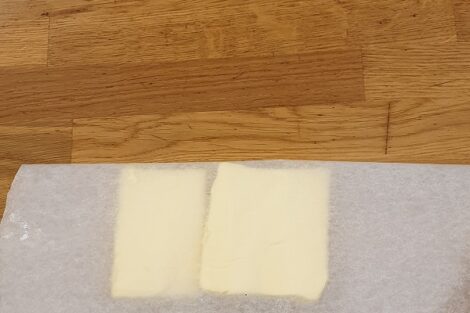
-
Using some baking paper and a rolling pin, beat the butter a little to get is softer. Your butter should be pliable. If it becomes to soft it will run off the pastry and not create layers. If it is too hard, it will break the dough layers through tearing it.
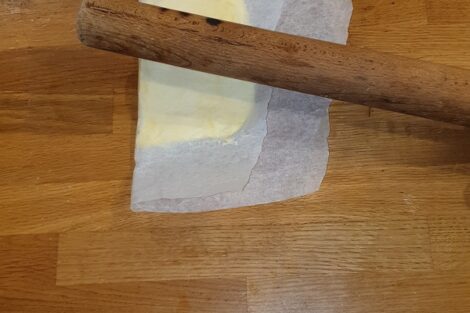
-
Keep beating and shaping your butter until it becomes a nice little rectangular shape (15 cm X 8 cm)
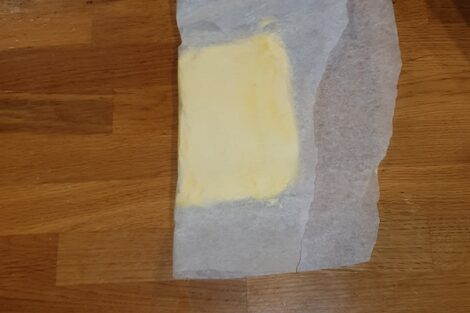
-
It is important to have your butter shaped, pliable and rolled out to size.
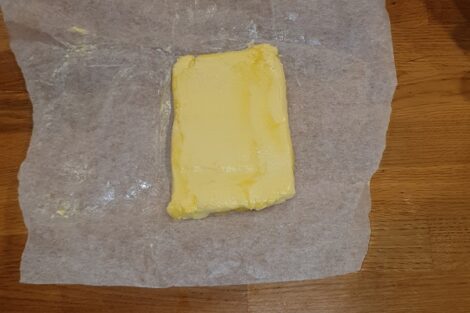 Adding the butter to the dough-Lamination process
Adding the butter to the dough-Lamination process
-
Dust a bit of flour on your bench.
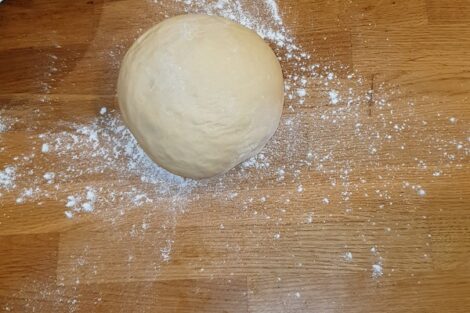
-
Roll out the pastry to a rectangular shape, just over twice the size of your butter
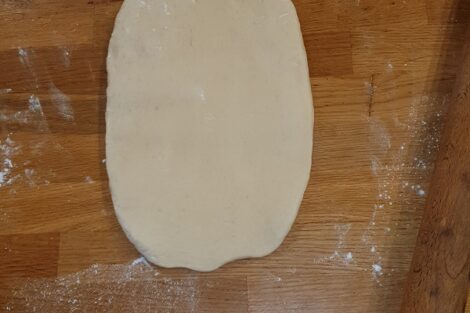
-
Place the butter on the left of your dough and fold on top the right hand side of the dough.
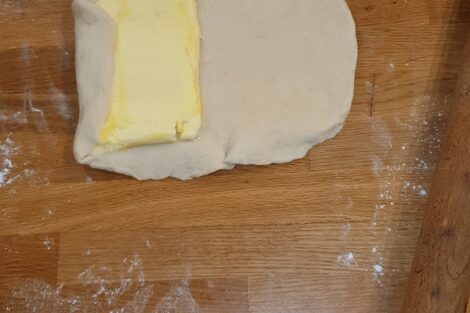
-
Seal the dough, by pinching with your fingers. This will avoid the butter to run out when rolling.
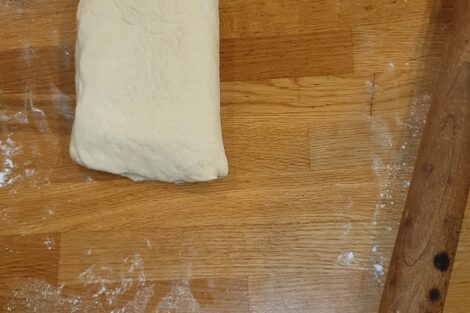
-
Try to reshape that rectangular shape with your hand. Be gentle and do not perforate the dough.
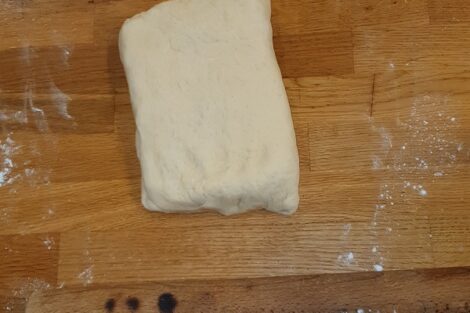
-
Roll out the dough by applying nice gentle pressure on the rolling pin.
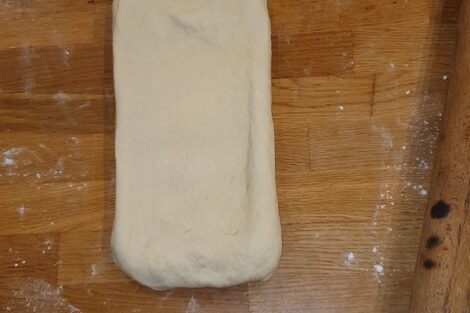
-
Keep rolling to a good 45 cm long and keep that rectangular shape.
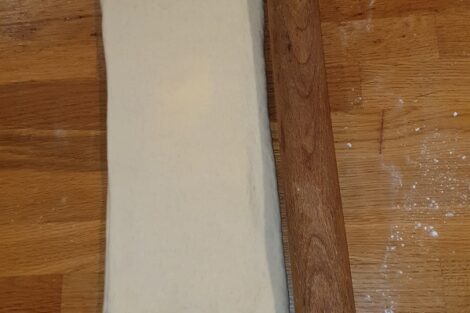
-
Now comes the folding process or what we call turns as professional.

-
Fold to a third of the dough. Take the top of the dough and fold to a third , then take the bottom of the dough and fold it on top. Once this is done, turn the dough clockwise by a 1/4 of a turn (90°). This is call a single turn.
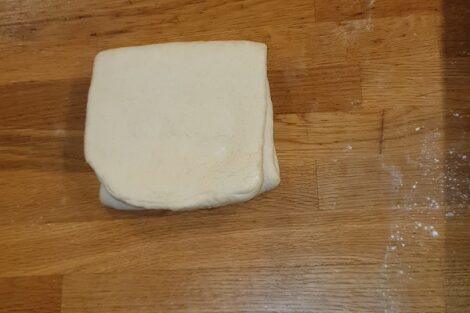
-
Then roll out the dough again has you just perform.
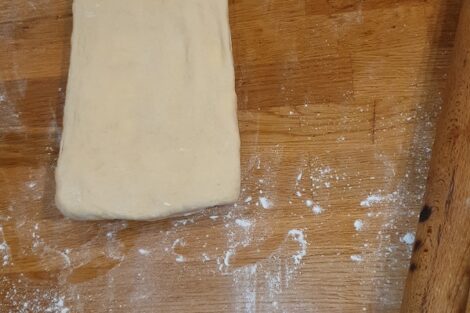
-
Keep the rectangular shape, check that the dough does not stick to the bench and that the butter is not coming out. now if the butter comes out . put he dough back in the fridge, It may be that it is to warm in your kitchen and everything is getting too soft.

-
We are going to fold again. But this time as a book fold. Take the bottom of the dough and fold it to the middle of your rectangular.

-
Do the same with the top.

-
then fold it again on top of each other. Give another 1/4 turn clockwise (90°). This is a double turn. Cover with plastic wrap and let it rest in the fridge for 30 min.
 Rolling out, cut and roll
Rolling out, cut and roll
-
Now the dough is rested, let the dough on the bench for 5 to 10 min. The Butter needs to come back to room temperature. Roll out your dough to 24 cm wide and 4 mm thin. here the length does not matter.
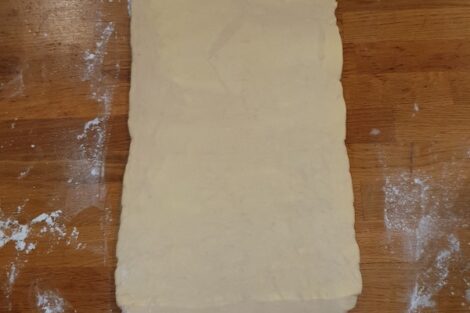
-
Once rolled out take a ruler and mark , cut the triangle ready to roll for the croissants. 24 cm long and 8 cm at the base. I generally start on on edge the left for example and from the edge i mark with knife 8 cm, 16 cm, 24, 32, and move on. On the other edge i start 4 cm of the edge and start marking form there (4 cm being half of 8 cm) then again 8, 16, 24, 32 and so on. Then with a long knife start playing connecting the dots (marks) to create perfect triangles.
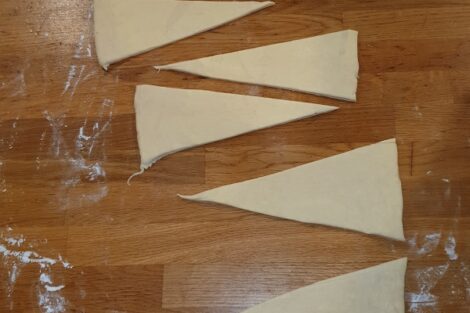
-
Brush the excess of flour with a gentle soft brush. and roll out the croissant from the wider side of the croissant to the smaller point. try to keep straight. Leave the point of the croissant tucked under the roll.
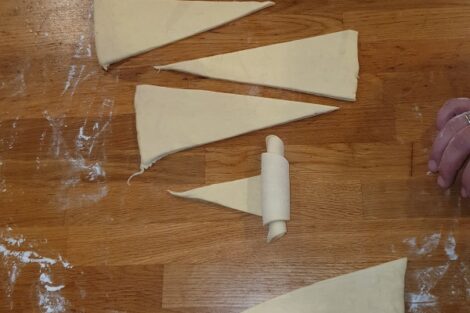
-
Keep rolling.
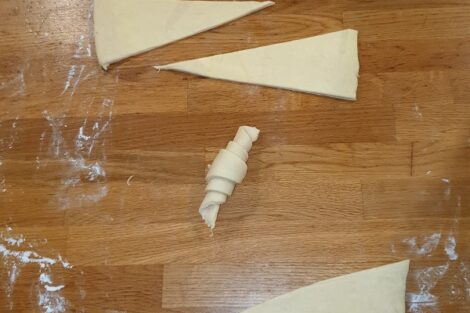
-
don't roll to tight just let the roll happening
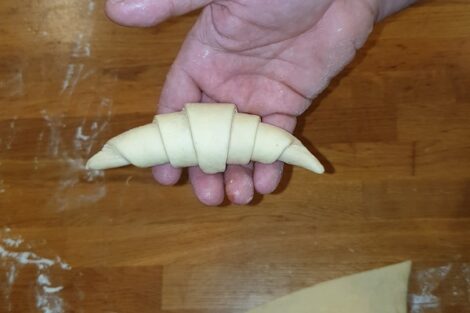 Prooving (Proofing) and Baking
Prooving (Proofing) and Baking
-
Place the croissants on baking or silicon paper or mat. Prove them to double in size.. so this is another tricky part.. Proving should be done in a humid environment and not over 30°C or the butter will run out of your croissant. Rare are the people that own a proover at home. So, i have a solution, i boil a water kettle and pour the water in a tray and place it in a SWITCHED OFF oven at the bottom and close the door. I wait 10 min for the water too cool down and then put my tray of croissant in for 30 min or until they double in size.
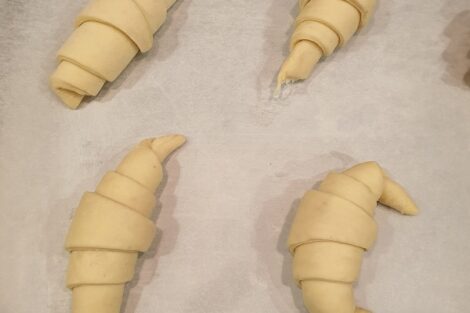
-
Meanwhile, i make my egg wash, with milk and egg
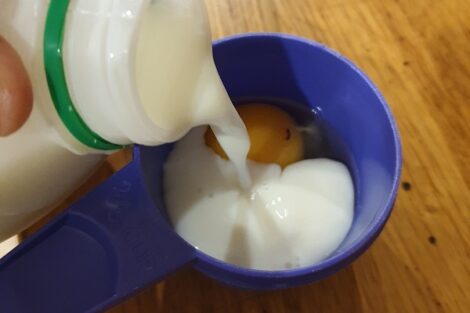
-
Beat well together.

-
Preheat your fan forced oven at 180°C. Once the croissants are proved i brush gently the egg wash on top of them just enough.. If you like glaze looking croissant, use a sauce pan and bring to boil the water and sugar. boil for 5 min and let it cool down.
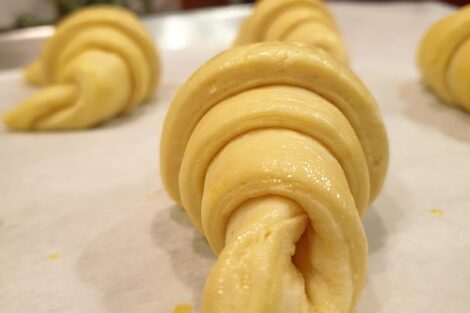
-
Bake the croissant for 20 minutes. look at that

-
Let the croissant cool down for 5 min and glaze them if you like it that way.

-
Voila, Bon Appetit. Bon Breakfast.

Notes
Allow yourself plenty of time to make the pastry. You can use these recipe and make ham and cheese croissants or Almond Croissants
Best you use a Bowl mixer for this recipe with a dough hook...
No fresh yeast no panic you can use Dry yeast instead... But you must find Bakers flour (high protein flour 1-14% for elasticity).
Resting the dough is very important. To rest the gluten and control elasticity.
Your butter should be pliable. If it becomes to soft it will run off the pastry and not create layers. If it is too hard, it will break the dough layers through tearing it.
Be patient, take your time.
Don't try to rush the proofing process.
Subscribe like and share for more recipes and tips
Here is a Link to the type of equipment I have used to create this recipe.
Bowl mixer Machine: https://amzn.to/30iOaJt
Silicon Baking Mat: https://amzn.to/30mHLNv
Pastry Brush: https://amzn.to/30iTAnN
Kitchen bowls: https://amzn.to/2V8EbAs
Baking Tray: https://amzn.to/2Va5BWU
Frenchy.
